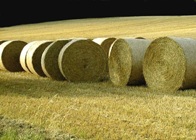Food v fuel

Harvest.
19 September 2011
Shifts in Food and Bioenergy Production needed to meet Global Challenges
Scientists at Aberystwyth University address one of the greatest challenges of the future: the use of land for new energy crops without harming food production.
Based at IBERS – the Institute for Biological, Environmental and Rural Sciences – they show how investment in dedicated new generation energy crops can make best use of limited resources.
Food is one of the basic needs of life, but civilisation also requires energy and the decline of fossil fuels has led to increased interest in bioenergy with proposals to use agricultural land to grow both food and fuel.
In a new review, published in Global Change Biology Bioenergy scientists from Aberystwyth University and The University of Aberdeen explore the advantages of bioenergy and how competition for land can be minimised.
“The development of bioenergy could represent a huge shift in agricultural development which helps to stimulate rural and urban development,” said Dr John Valentine from IBERS Aberystwyth University “However, it is vitally important that bioenergy does not jeopardise food production.
“Our research sets out a vision for bioenergy in terms of four major gains for society: a reduction in carbon emissions by replacing fossil fuels with appropriate crops for energy generation; a significant contribution to energy security by reductions in fossil fuel dependence; rural and urban economic development, and reduced dependence of global agriculture on fossil fuels.”
The team explored the factors which need to be taken into account when assessing how to balance food and fuel production from land in a changing world. These include food requirements, the economics of energy crops on less favourable land, gains in productivity of crop and animal production, the effects of reducing meat production, and the economic value of bioenergy production in terms of its value for energy and the value of carbon emissions saved.
Energy at crude oil price of $100 per barrel is estimated at $55-$330bn, while carbon value is estimated at $56-$218bn at a price of $40 per tonne.
As an example of initiatives which could be used to save land the team turned to ‘next generation’ perennial energy crops, such as the giant grass Miscanthus. These energy crops do not require large amounts of agrochemical input, they help avoid the destruction of native forests and minimise competition with primary food production, rather than with inefficient first-generation grain, tuber and oilseed crops.
“Rather than restricting bioenergy crops to land which is ‘left over’ from food production, switching to dedicated energy crops would reduce direct competition with food production”, said Valentine. “This shift should be matched by reducing food waste and reducing consumption of red meat from grain-fed systems.”
Professor Pete Smith of the University of Aberdeen concluded: “We need to invest heavily in food and energy if the needs of a world population expected to reach 9 billion by 2050 at a time of climate change are to be met. Land is a finite resource which we must use wisely. As Mark Twain neatly put it: ‘Buy land. They’re not making it anymore.”
This paper is published in Global Change Biology: Bioenergy. To request a copy contact Lifesciencenews@wiley.com or +44 (0) 1243 770 375
Full Citation:
Valentine, J, Clifton-Brown, J, Hastings, A, Robson, P, Allison, G and Smith, P, “Food vs. fuel: the use of land for lignocellulosic ‘next generation’ energy crops that minimise competition with primary food production", Global Change Biology Bioenergy, Wiley-Blackwell, DOI: 10.1111/j.1757-1707.2011.01111.x
URL: http://onlinelibrary.wiley.com/doi/10.1111/j.1757-1707.2011.01111.x/abstract



